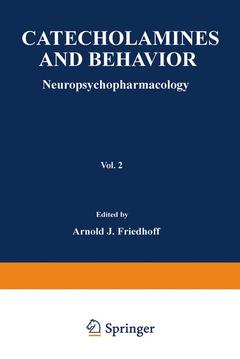Description
Catecholamines and Behavior · 2, Softcover reprint of the original 1st ed. 1975
Neuropsychopharmacology
Language: English
Subject for Catecholamines and Behavior · 2:
Publication date: 04-2012
225 p. · 15.2x22.9 cm · Paperback
225 p. · 15.2x22.9 cm · Paperback
Description
/li>Contents
/li>
This volume is intended to provide students and investigators of brain-be havior relationships with an understanding of the current concepts of the role of catecholamines in the regulation of behavior. Catecholamines are now believed to be modulators or transmitters in systems regulating a number of important aspects of behavioral function. The present intense interest in catecholamines is reflected by the large number of scientific reports dealing with these compounds. Even those reports which are rele vant to behavior are staggering in number. The contributors to this book have drawn on the salient literature, as well as on their own work, with a view toward clarifying relationships between the basic neurobiology of cate cholaminergic neural systems and normal and abnormal behavioral func tion. Current work in this field is heavily dependent on the use of psychotropic drugs to produce model behavioral states, or as biological probes. As a result psychopharmacological studies are generously represented. I n the last chapter of Volume 2 the editor has attempted to further relate and develop the material in the two volumes from the con ceptual and theoretical standpoint. New York AJF Contributors to Volume 2 Wagner H. Bridger, Department oj Psychiatry, Albert Einstein College oj Medicine, Bronx, New York Thomas R. Bozewicz, Department oj Psychiatry, Albert Einstein College oj Medicine, Bronx, New York Doris H. C1ouet, Testing and Research Laboratory, New York State Drug Abuse Control Commission, Brooklyn, New York John M.
1 The Role of Catecholamines in Animal Learning and Memory.- 1. Definitions.- 1.1. Catecholamines.- 1.2. Learning and Memory.- 2. Problems of Specificity.- 2.1. Behavioral Specificity.- 2.2. Chemical Specificity.- 2.3. Anatomical Specificity.- 3. Experimental Approaches 6.- 3.1. CA Activity as Independent Variable.- 3.2. Behavior as Independent Variable.- 4. CA as Independent Variable 6.- 4.1. Chemical Specificity.- 4.2. Anatomical Specificity.- 4.3. Acquisition.- 4.4. Memory.- 4.5. Postacquisition Performance.- 5. Behavior as Independent Variable 19.- 5.1. Problems with CA as Dependent Variable.- 5.2. Negatively Reinforced Behavior.- 5.3. Positively Reinforced Behavior.- 5.4. Interpretation.- 6. Conclusions.- 7. References.- 2 Stress and Catecholamines.- 1. Introduction.- 2. Tissue Levels of Norepinephrine and Dopamine.- 3. Turnover.- 4. Metabolites.- 5. Functional Significance.- 6. References.- 3 The Catecholamines: Possible Role in Affect, Mood, and Emotional Behavior in Man and Animals.- 1. Introduction.- 2. Catecholamines and Affect: Historical Perspectives.- 2.1. Affects, Mood, and Emotional States as Objects of Scientific Study.- 2.2. Specification of the Catecholamines and Catecholamine-Related Anatomical Sites Involved in Affect-Related Behavior.- 3. Catecholamines and Affect: Methodologic Issues in Human and Animal Studies.- 3.1. Problems in the Assessment of Affects and Affect-Related Behavior in Man.- 3.2. Problems in the Utilization of Animal Behavioral Models for the Study of Affect-Related Behavior.- 3.3. Problems in the Experimental Manipulation of Catecholamine Metabolism.- 4. Affect-Related Behavior Resulting from the Administration of Catecholamines and Catecholamine-Altering Drugs.- 4.1. Effects of Directly Administered Catecholamines.- 4.2. Effects of Catecholamine Precursors and Catecholamine Synthesis-Inhibiting Drugs.- 4.3. Effects of Other Drugs Which Alter Catecholamine Metabolism.- 5. Alterations in Catecholamine Metabolism Resulting from Affect-Related Behavior.- 5.1. Direct Measurement of Catecholamines in Depression.- 5.2. Direct Measurement of Catecholamines in Mania.- 5.3. Nonspecific Factors Including Physical Activity as Variables in the Study of Catecholamines in Man.- 5.4. Studies of Catecholamine-Related Enzymes in Patients with Depression and Mania.- 6. Interrelationships between Affects and Psychomotor Activation: A Reevaluation of the Role of Catecholamines in Affect-Related Behavior.- 6.1. Affects and the “Affective Disorders”.- 6.2. Affects and Catecholamines.- 6.3. Catecholamines and the Present Status of the Biogenic Amine Hypotheses for Mania and Depression.- 7. Summary.- 8. References.- 4 Catecholamines and Depression: A Further Specification of the Catecholamine Hypothesis of the Affective Disorders.- 1. Introduction.- 2. Metabolism of Norepinephrine.- 3. MHPG in Affective States.- 4. Subgroups of Depression.- 5. Biochemical Mechanisms in Affective Disorders.- 6. Summary.- 7. References.- 5 Catecholamines and Psychosis.- 1. Introduction.- 2. Dopamine Theory of Schizophrenia.- 3. Amphetamine Psychosis as a Model.- 4. Mechanism of Amphetamine Psychosis.- 4.1. Effect of Drugs on Amphetamine Psychosis.- 4.2. Evidence Involving Dopamine.- 5. Transmitter Balance.- 6. Two-Factor Theory of Schizophrenia.- 7. References.- 6 Serum Dopamine-?-Hydroxylase in Various Pathological States.- 1. Introduction.- 2. Determination of D?H Activity in Human Serum.- 3. Determination of Immunoreactive (IR) D?H Levels in Human Serum.- 4. Serum D?H Levels: Enzymatic Assay Versus Radioimmunoassay.- 5. Serum D?H Activity in Neuroblastoma.- 6. Serum D?H Activity in Familial Dysautonomia.- 7. Serum D?H Levels in Down’s Syndrome.- 8. Serum D?H Activity in Affective States.- 9. Discussion and Conclusions.- 10. References.- 7 Possible Roles of Catecholamines in the Action of Narcotic Drugs.- 1. Introduction.- 2. Effects of Other Drugs on Opiate Activity.- 2.1. Monoamine Oxidase Inhibitors.- 2.2. Tricyclic Antidepressants.- 2.3. Adrenergic Blocking Agents.- 2.4. Amine Depletors.- 2.5. Inhibitors of Catecholamine Synthesis.- 2.6. Catecholamines and Precursors.- 2.7. Amphetamines and Cocaine.- 2.8. Neuroleptic Drugs.- 2.9. Apomorphine and Amantadine.- 2.10. 6-Hydroxydopamine.- 3. Opiate-Induced Alterations in the Levels of Brain Catecholamines.- 4. Opiate-Induced Alterations in the Turnover of Brain Catecholamines.- 5. Effects of Opiates on the Transport of Catecholamines.- 6. Effects of Opiates on the Adenyl Cyclase System in Brain.- 7. Dopamine Receptor Hypothesis.- 8. Discussion and Conclusions.- 8.1. A Unique Role for a Single Neurotransmitter.- 8.2. Role of Catecholamines in Dependence.- 8.3. Site of Opiate Action.- 9. References.- 8 Metabolic Adaptation to Antidepressant Drugs: Implications for Pathophysiology and Treatment in Psychiatry.- 1. Biochemical Indices of Psychotropic Drug Action.- 2. Adaptive Mechanisms in Central Synapses.- 3. Enzymatic Adaptation to Chronic Drug Administration.- 4. A Model for Neurochemical Adaptation to Tricyclic Drugs.- 5. A Revised Theory of Depressive Illness.- 6. References.- 9 Integration and Conclusions.- 1. Introduction.- 2. Research Strategies.- 3. Determinants of Behavior.- 4. Conceptual Models for the Multiple Roles of Catecholamines in Brain.- 5. New Conceptual Models of Psychopathological States.- 6. Development of New Treatments.- 7. Directions for Future Research.
© 2024 LAVOISIER S.A.S.




